Home
>
Chords
/ Theory
>
Chord Inversions
Using its simplest definition, a chord inversion is where the root is not the lowest note (often called the bass note) in a chord. This means another note in the chord occupies the bass position.
You'll often see these altered bass chords written as slash chords (e.g. C/E would imply a C major chord with an E bass note).
So all we're doing is rearranging the stack of notes in a chord, giving us several possible voicings of the same chord. The benefits of mastering chord inversions are two-fold:
1. You'll have more voicing options for a given chord. Inversions give you more specific voicings of each note in a chord, meaning a better flow of harmony through your chord changes. You'll hear what I mean as you progress.
2. You'll be able to play chords in more positions on the fretboard. This means more economical fingering and therefore more possibilities for adding additional notes e.g. for creating phrases around the chord shape.
Video Lesson
For example, a G major triad would consist of the notes G, B and D.
These are the standard triad "stacks", with the root on the bass, that occur in the most common chord shapes, like below.
So in the first chord form, we see the 3rd is built on the root whereas in the second chord form, the 5th is built on the root. Even though there is a different ordering of notes above the root octave in the second example, it's the bass note we're particularly interested in when determining an inversion.
Because the root note acts as the bass in both these forms, they will sound quite similar, although it's good to know both forms for lead voicing (for example, if you specifically need a lower sounding 3rd, you would use the 1 3 5 chord form).
It's when you start moving the root out of the bass position that the chord starts to sound altered.
As mentioned before, an inversion occurs when the root is not the bass note of the chord. This means one of the other notes in the chord acts as the bass and the root gets stacked above that note along with any other chord tones.
So, let's say you wanted a 1st inversion G major chord. Simply find the root note of G on the D, G or B strings and build one of the corresponding forms below (you should memorise these shapes)...
You'll notice that these chord forms are very similar to the root and 1st inversion forms, with perhaps only one note difference. However, it's good to be able to break chord forms down like this, to have the option of using different strings for different voicings.
On the fretboard, we can simply take the major forms and flatten the 3rd to a minor 3rd...
It's up to you if you use the octave (higher) minor 3rd in these forms. They just help "thicken" up the chord.
Again, you can add the octave 5th above the minor 3rd if you wish.
In the next part we'll look at 7th chord inversions.
In the meantime, try incorporating the above guitar chord inversions in to your practice routine and songwriting. The more you play around with them, the more your ear will be trained to identify such chords and anticipate them in a chord sequence.
Chord Inversion Positions
Movable Guitar Chords
Main Guitar Chords Section
Guitar Theory Lessons
Guitar Chord Inversions Demystified
This series of lessons will help you understand how guitar chord inversions are constructed. Chord inversion is a relatively advanced concept, but it shouldn't be difficult to grasp if you've been through the chord theory series. Free chord
cheat sheet Free chord
cheat sheetLearn how guitar chords work together in any key... Click here to start now |
Using its simplest definition, a chord inversion is where the root is not the lowest note (often called the bass note) in a chord. This means another note in the chord occupies the bass position.
You'll often see these altered bass chords written as slash chords (e.g. C/E would imply a C major chord with an E bass note).
So all we're doing is rearranging the stack of notes in a chord, giving us several possible voicings of the same chord. The benefits of mastering chord inversions are two-fold:
1. You'll have more voicing options for a given chord. Inversions give you more specific voicings of each note in a chord, meaning a better flow of harmony through your chord changes. You'll hear what I mean as you progress.
2. You'll be able to play chords in more positions on the fretboard. This means more economical fingering and therefore more possibilities for adding additional notes e.g. for creating phrases around the chord shape.
Video Lesson
Major triad guitar chord inversions
From the first chord theory lesson, we learned that a major triad consists of a root (1), 3rd (3) and 5th (5).For example, a G major triad would consist of the notes G, B and D.
Root position
With the root note as the lowest note in the chord, we have two possible root voicings. These are called root positions because the root is the note on which the other chord tones are stacked...| 1 3 5 | 1 5 3 |
These are the standard triad "stacks", with the root on the bass, that occur in the most common chord shapes, like below.
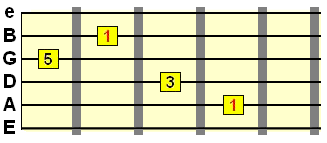 |
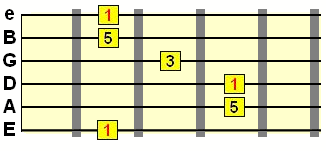 |
So in the first chord form, we see the 3rd is built on the root whereas in the second chord form, the 5th is built on the root. Even though there is a different ordering of notes above the root octave in the second example, it's the bass note we're particularly interested in when determining an inversion.
Because the root note acts as the bass in both these forms, they will sound quite similar, although it's good to know both forms for lead voicing (for example, if you specifically need a lower sounding 3rd, you would use the 1 3 5 chord form).
It's when you start moving the root out of the bass position that the chord starts to sound altered.
As mentioned before, an inversion occurs when the root is not the bass note of the chord. This means one of the other notes in the chord acts as the bass and the root gets stacked above that note along with any other chord tones.
1st inversion
With a 1st inversion of a major triad, the 3rd becomes the bass and the 5th and root are stacked above it...3 5 1
So, let's say you wanted a 1st inversion G major chord. Simply find the root note of G on the D, G or B strings and build one of the corresponding forms below (you should memorise these shapes)...
E string
bass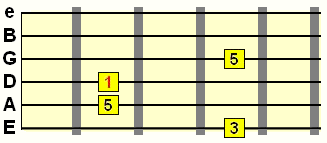 |
A string
bass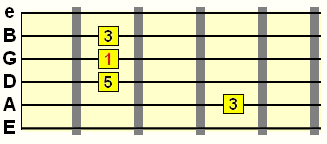 |
D string bass 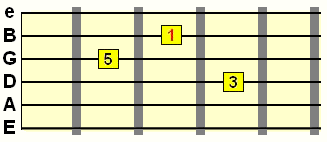 |
2nd inversion
As you can probably guess by process of elimination, with 2nd inversion triads, the 5th becomes the bass with the root and 3rd above it... 5 1 3
You'll notice that these chord forms are very similar to the root and 1st inversion forms, with perhaps only one note difference. However, it's good to be able to break chord forms down like this, to have the option of using different strings for different voicings.
E string
bass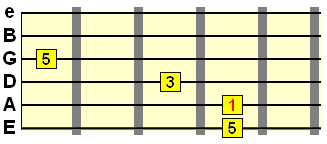 |
A string
bass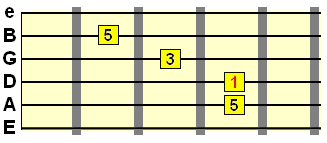 |
D string bass 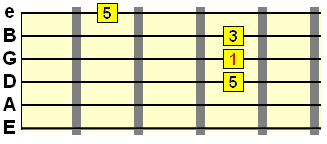 |
Major chord inversion chart
The below table may come in handy for referencing specific chords and their inversions.| Triad | Root Pos. (1 3 5) |
1st Inv. (3 5 1) |
2nd Inv. (5 1 3) |
| Cmaj | C E G | E G C | G C E |
| C#maj | C# E# G# | E# G# C# | G# C# E# |
| Dmaj | D F# A | F# A D | A D F# |
| Ebmaj | Eb G Bb | G Eb Bb | Bb Eb G |
| Emaj | E G# B | G# E B | B E G# |
| Fmaj | F A C | A C F | C F A |
| F#maj | F# A# C# | A# C# F# | C# F# A# |
| Gmaj | G B D | B D G | D G B |
| Abmaj | Ab C Eb | C Eb Ab | Eb Ab C |
| Amaj | A C# E | C# E A | E A C# |
| Bbmaj | Bb D F | D F Bb | F Bb D |
| Bmaj | B D# F# | D# F# B | F# B D# |
| Test your knowledge using this interactive fretboard learning software. |
Minor triad guitar chord inversions
If you've come this far, you should know that a minor triad consists of a root (1), minor 3rd (b3) and 5th (5).Root position
Just like with major triads, when the root note is the bass note of the chord, we have two root positions...| 1 b3 5 | 1 5 b3 |
On the fretboard, we can simply take the major forms and flatten the 3rd to a minor 3rd...
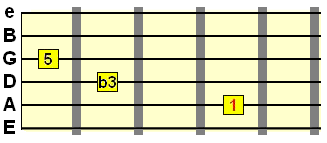 |
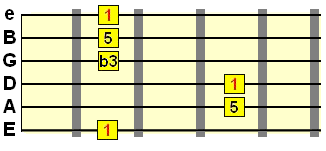 |
1st inversion
With a minor triad first inversion, the minor 3rd becomes the bass and the 5th and root are stacked above...b3 5 1
It's up to you if you use the octave (higher) minor 3rd in these forms. They just help "thicken" up the chord.
E string
bass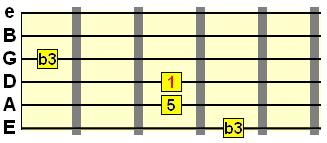 |
A string
bass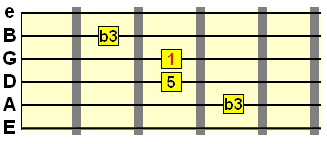 |
D string bass 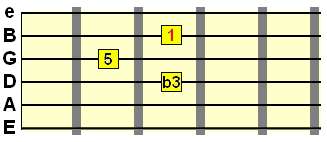 |
2nd inversion
The 5th becomes the bass with the root and minor 3rd above it... 5 1 b3
Again, you can add the octave 5th above the minor 3rd if you wish.
E string
bass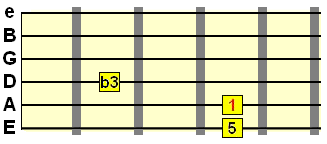 |
A string
bass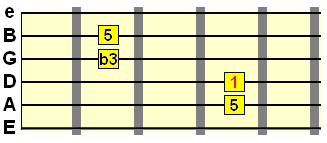 |
D string bass 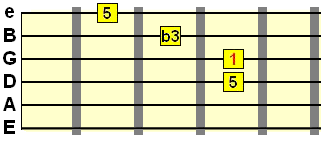 |
| Tip:
A lot of these inversion forms are just cut down shapes from the common
barre
chord forms you might know. For example the D string bass form above is simply the A shape minor barre chord without the root on the A string. Can you see it? The A string bass form above is taken straight from the E shape minor barre chord shape. This is why it's beneficial to learn those E, A, D, C and G form chords early on, because most other chord shapes are derived from them. These core shapes contain all the 3/4 note inversions you'll ever need. |
Minor chord inversion chart
| Triad | Root Pos. (1 b3 5) |
1st Inv. (b3 5 1) |
2nd Inv. (5 1 b3) |
| Cm | C Eb G | Eb G C | G C Eb |
| C#m | C# E G# | E G# C# | G# C# E |
| Dm | D F A | F A D | A D F |
| Ebm | Eb Gb Bb | Gb Eb Bb | Bb Eb Gb |
| Em | E G B | G E B | B E G |
| Fm | F Ab C | Ab C F | C F Ab |
| F#m | F# A C# | A C# F# | C# F# A |
| Gm | G Bb D | Bb D G | D G Bb |
| Abm | Ab Cb Eb | Cb Eb Ab | Eb Ab Cb |
| Am | A C E | C E A | E A C |
| Bbm | Bb Db F | Db F Bb | F Bb Db |
| Bm | B D F# | D F# B | F# B D |
In the next part we'll look at 7th chord inversions.
In the meantime, try incorporating the above guitar chord inversions in to your practice routine and songwriting. The more you play around with them, the more your ear will be trained to identify such chords and anticipate them in a chord sequence.
| |
Tweet |
Stay updated and learn more
Sign up to the newsletter for updates and grab your free Uncommon Chords book
Sign up to the newsletter for updates and grab your free Uncommon Chords book
Related Lessons
Chord Inversion Positions
Movable Guitar Chords
Main Guitar Chords Section
Guitar Theory Lessons








